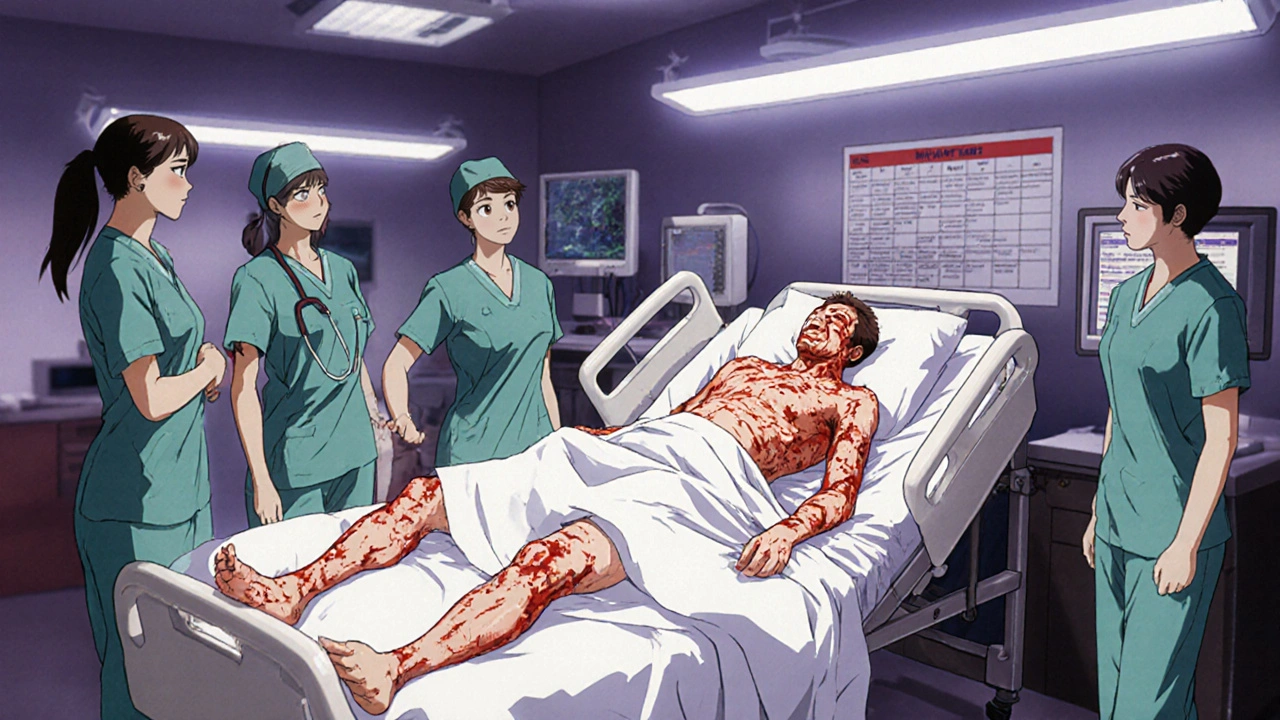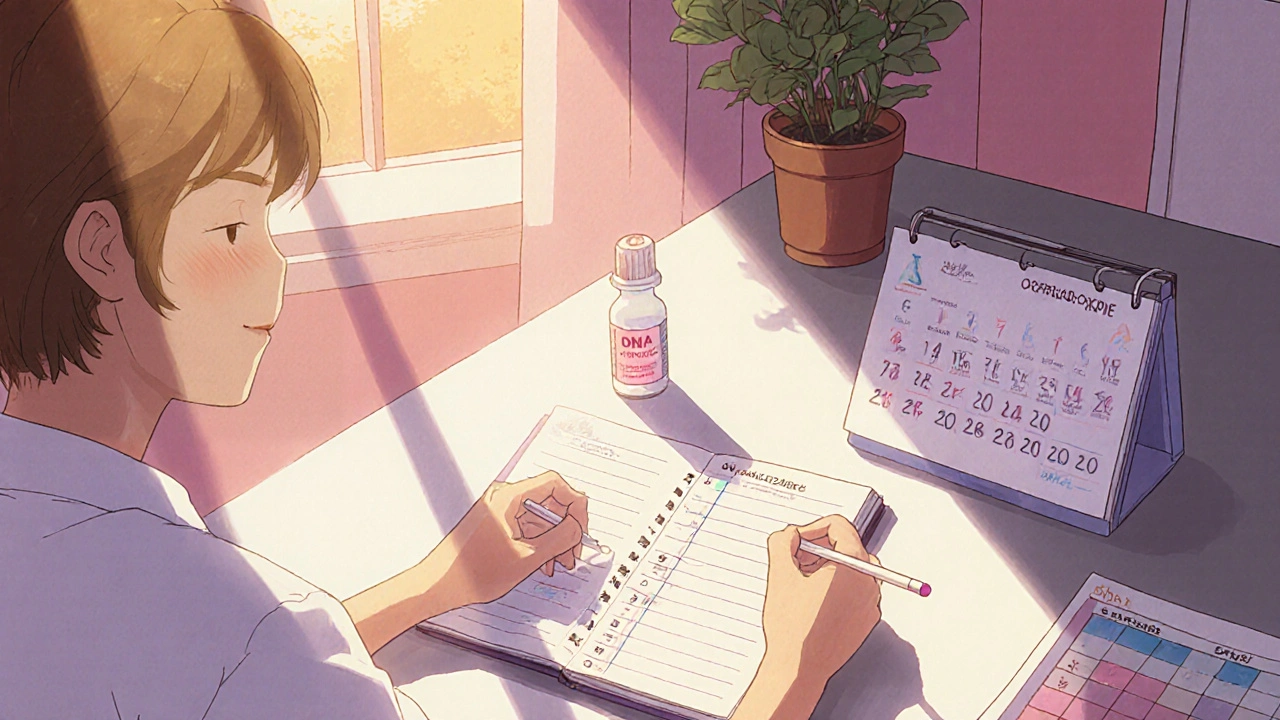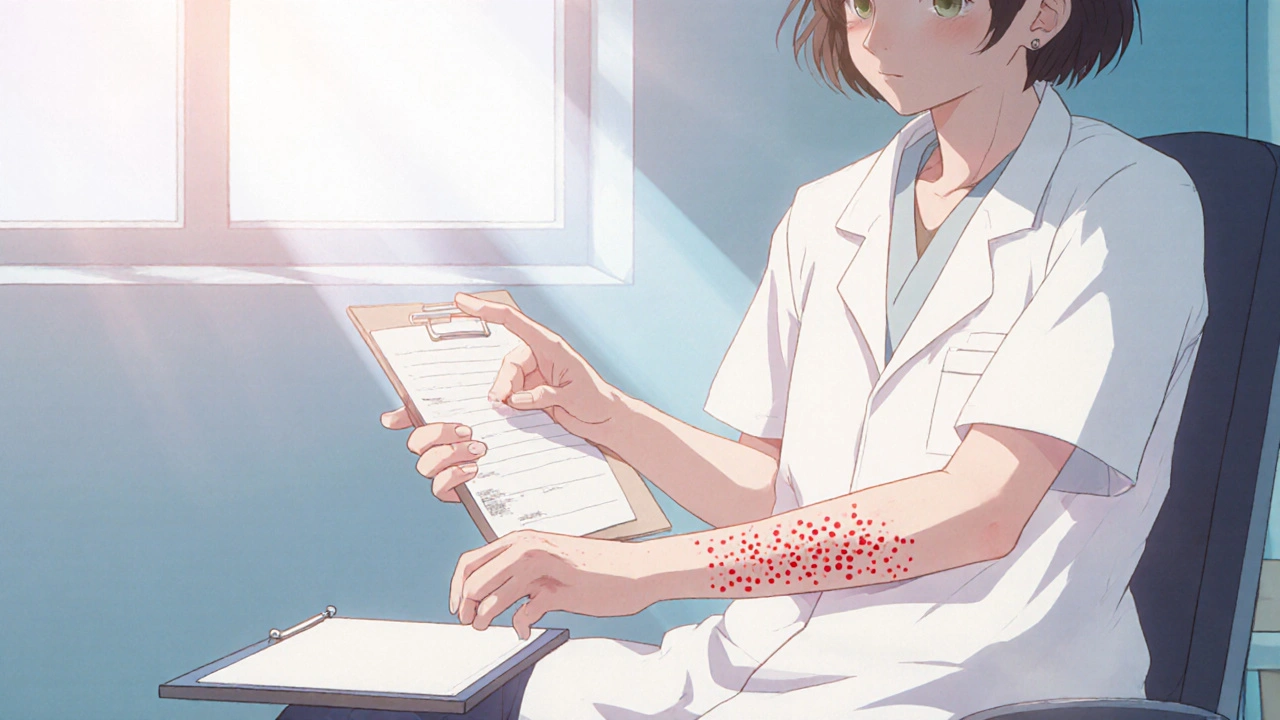Oxcarbazepine Skin Reaction Risk Assessment
Personal Risk Assessment
This tool helps you understand your individual risk for skin reactions while taking Oxcarbazepine based on key factors from the article.
Your Risk Assessment Results
When you start Oxcarbazepine is a second‑generation anticonvulsant used for epilepsy and mood disorders, you’re hoping for steady seizure control, not a rash that spreads across your arms. Unfortunately, skin reactions are one of the more frequent adverse effects, ranging from a mild itch to life‑threatening conditions like Stevens‑Johnson syndrome (SJS). Knowing what to look for, who’s most at risk, and how to act fast can keep a rash from turning into a medical emergency.
What is Oxcarbazepine and why does it cause skin issues?
Oxcarbazepine works by stabilising neuronal membranes and reducing the release of excitatory neurotransmitters. It’s chemically similar to carbamazepine, a drug notorious for skin reactions, especially in people with certain genetic markers. The same metabolic pathways-mainly the liver enzyme CYP3A4-break down Oxcarbazepine into reactive metabolites that can trigger an immune response in the skin.
Typical skin reactions you might notice
- **Mild maculopapular rash** - flat or raised red bumps, often starting on the trunk.
- **Pruritus (itching)** - may appear without an obvious rash, sometimes just a sensation of tight skin.
- **Urticaria (hives)** - welts that come and go, usually pink or red.
These reactions usually surface within the first two weeks of therapy and often resolve on their own or after a dose reduction. However, they can be a red flag that a more severe reaction is brewing, so keep an eye on any change.
Severe cutaneous adverse reactions (SCARs)
Although rare, SCARs demand immediate medical attention. The three big players are:
- Stevens‑Johnson syndrome - characterized by blistering and detachment of the skin and mucous membranes. Onset typically occurs 1‑3 weeks after starting the drug.
- Toxic epidermal necrolysis (TEN) - a more extensive form of SJS where >30% of body surface area sloughs off. Mortality can exceed 30%.
- DRESS syndrome (Drug Reaction with Eosinophilia and Systemic Symptoms) - presents with fever, facial swelling, enlarged lymph nodes, and a widespread rash that may involve internal organs.
All three share a common thread: a rapid escalation from a simple rash to widespread skin loss, sometimes accompanied by fever, sore throat, or organ dysfunction. The key is early recognition.
Who is most at risk?
Several factors raise the odds of a serious skin reaction:
- Genetic predisposition - the HLA‑B*1502 allele, common in people of Asian ancestry, is linked to carbamazepine‑induced SJS and increases the risk for Oxcarbazepine as well.
- Concomitant drugs - combining Oxcarbazepine with other aromatic anticonvulsants (e.g., carbamazepine, phenytoin) can amplify the immune response.
- Previous drug rash - a history of any drug‑induced rash, especially severe ones, suggests a hypersensitive immune system.
- Age and renal function - older adults and those with impaired kidney clearance may accumulate higher drug levels, pushing the immune system over the edge.
If you fall into one of these categories, your doctor may order a genetic test before prescribing Oxcarbazepine or choose an alternative drug.

Early warning signs that shouldn’t be ignored
Think of your skin as a canary in a coal mine. The following clues merit a quick call to your healthcare provider:
- New rash that spreads beyond the initial spot.
- Blisters or painful erosions on the lips, gums, eyes, or genitals.
- Fever >38°C (100.4°F) accompanied by a rash.
- Swelling of the face or neck.
- Unexplained itching that becomes intolerable.
Document the onset date, progression, and any accompanying symptoms. A photo can be surprisingly helpful when you speak with a dermatologist.
What to do if a reaction occurs
Time is critical. Here’s a step‑by‑step plan:
- Stop Oxcarbazepine immediately. Do not try to taper on your own; discuss any seizure‑control strategy with a neurologist.
- Call your prescriber or go to the nearest emergency department if you notice blisters, mucosal involvement, or a fever.
- Inform the medical team about any other medications you’re taking, including over‑the‑counter products.
- If admitted, expect supportive care: wound dressings, fluid replacement, and possibly systemic steroids or intravenous immunoglobulin for severe cases.
- Ask for documentation of the adverse reaction. This will be useful for future prescribing and for insurance or medic‑legal purposes.
Most mild rashes fade within a week after discontinuation, but severe reactions may need weeks of hospitalization and a long recovery period.
Managing the risk: monitoring and alternatives
Even if you never develop a rash, proactive monitoring is a smart move.
- Baseline check: before starting, get a full skin exam and discuss HLA‑B*1502 testing if you have Asian heritage.
- Follow‑up visits: schedule a review 1-2 weeks after initiation, then monthly for the first three months.
- Alternative meds: if you’re high‑risk, consider drugs with a lower rash profile, such as levetiracetam or valproic acid, though each has its own side‑effect spectrum.
Remember, the goal is to keep seizures under control without trading one health problem for another.

Quick checklist for patients and caregivers
- Know your genetic risk (HLA‑B*1502 screening).
- Track any skin changes daily for the first month.
- Call your doctor if a rash spreads, blisters form, or you develop a fever.
- Never restart Oxcarbazepine after a serious reaction without specialist guidance.
- Keep a list of all medications in case of future prescriptions.
Comparison of common Oxcarbazepine‑related skin reactions
| Reaction | Typical incidence | Onset (days) | Mortality risk | Management |
|---|---|---|---|---|
| Maculopapular rash | ~5‑10% | 3‑14 | Negligible | Observe or discontinue if worsening |
| Urticaria | ~2‑4% | 2‑10 | Negligible | Antihistamines; stop if severe |
| Stevens‑Johnson syndrome | 0.01‑0.1% | 7‑21 | 5‑10% | Immediate stop; hospital care |
| Toxic epidermal necrolysis | ~0.001% | 10‑28 | 30‑40% | Immediate stop; intensive care |
| DRESS syndrome | ~0.02% | 14‑60 | 10‑20% | Stop drug; steroids; organ monitoring |
Bottom line
Oxcarbazepine can be a game‑changer for seizure control, but oxcarbazepine skin reactions are a real safety issue. By understanding the typical timeline, recognizing warning signs, and acting quickly, you can protect yourself or a loved one from the worst outcomes. Talk openly with your prescriber, keep a skin diary, and don’t hesitate to seek help the moment something looks off.
Can a mild rash turn into Stevens‑Johnson syndrome?
Yes, a seemingly harmless rash can be an early sign of SJS. That’s why it’s crucial to report any new skin changes, especially if they spread or involve mucous membranes.
Should I get HLA‑B*1502 testing before starting Oxcarbazepine?
If you have Asian ancestry or a family history of drug‑induced skin reactions, genetic testing is strongly recommended. It can spare you from a life‑threatening event.
How long should I stay on Oxcarbazepine before the rash risk drops?
Most mild reactions appear within the first two weeks. Severe SCARs typically emerge within the first month, so vigilant monitoring is key during that period.
Is it safe to switch to another anticonvulsant if I develop a rash?
Switching is possible, but it should be guided by a neurologist. Some alternatives share similar risk profiles, so a careful assessment is needed.
What immediate treatment is given for DRESS syndrome?
The first step is stopping the offending drug. Systemic corticosteroids are often used, and organ function (liver, kidneys, heart) is closely monitored.


Comments (15)
Zachary Blackwell October 23 2025
Look, the big pharma guys love to hide the nasty side‑effects of drugs like Oxcarbazepine because they want the sales numbers to stay sky‑high. They push it as a “miracle” for seizures while silently hoping you won’t read the fine print about SJS and DRESS. The only way they keep us in the dark is by downplaying the genetic risk factors and bragging about “clinical trials” that totally ignore minority populations. If you’re not glued to every FDA alert, you’ll miss the red flags that the manufacturers conveniently bury in obscure journals. So keep your eyes peeled, demand a full HLA‑B*1502 test, and never trust a pill that comes with a glossy brochure but no warning label on the box.
prithi mallick October 24 2025
i think the biggest thing is to stay calm and actually listen to your own skin – it will tell you when something is off. having a rash might feel scary, but often it’s just a mild reaction that will fade if you stop the med early. remember to take photos, write down exactly when the spots appeared, and share those details with your doctor. a little patience and clear communication can save you from a nightmare later. also, dont be hard on yourself if you missed a day – the body needs time to recover, and you deserve compassion.
James Gray October 25 2025
Hey folks, just wanted to add a friendly shout‑out to everyone digging into the Oxcarbazepine skin stuff. First off, props to the OP for laying out the warning signs in such a clear way. If you’re starting this med, think of it like a new teammate – you gotta watch its moves before you trust it completely. A mild maculopapular rash usually shows up within a week or two and often goes away if you chill on the dose. But if that rash starts spreading, getting itchy, or you notice blisters on your lips or eyes, that’s the body sending an SOS. The HLA‑B*1502 test is like a security badge – it tells you whether you’re walking into a minefield. Even if you’re not of Asian descent, keep in mind that other genes can still make you vulnerable, so a honest chat with your neurologist is key. When you document the rash, snap a pic, note the date, and write down any fever or swelling – this info is gold for the doc. If you ever feel a sudden fever over 38°C with a rash, treat it like a fire alarm and call your doctor right away. Stopping the drug ASAP is the only real way to halt progression to SJS or TEN, and the hospital will take over from there. For milder reactions, antihistamines and a brief drug holiday can soothe the itch without jeopardizing seizure control. Meanwhile, there are alternative meds like levetiracetam that have a lower rash profile, but each comes with its own quirks. Keep an eye on your kidney function too, because older folks or those with reduced clearance can build up more of the drug. Bottom line: stay proactive, keep a skin diary, and never ignore a weird sensation – it’s better to be safe than sorry. And remember, the goal is seizure freedom without turning your skin into a battlefield, so partner up with your healthcare team and stay informed.
Scott Ring October 26 2025
Totally agree with you – that skin diary trick really makes a difference. I’ve seen patients catch a rash early simply because they noted the color change each day. It’s also worth mentioning that a quick lab check for eosinophils can help flag DRESS before it spirals.
Shubhi Sahni October 27 2025
Great summary!! Remember to schedule that follow‑up appointment at 1‑2 weeks!! If you notice any new bumps, even tiny ones, call your doctor immediately!! Early intervention can prevent serious outcomes!!!
Danielle St. Marie October 28 2025
Honestly, the drug industry is full of bull**** 😤. They want you on Oxcarbazepine without telling you about the deadly rash risk. If you’re American, demand transparent labeling 🇺🇸! No one should risk SJS because a pharma rep whispered “it’s safe”. 💊🚫
keerthi yeligay October 29 2025
We need more awareness about the HLA‑B*1502 test; many patients miss this crucial step.
Peter Richmond October 30 2025
Indeed, incorporating HLA‑B*1502 screening into pre‑treatment protocols can significantly reduce the incidence of severe cutaneous adverse reactions, and clinicians should consider it standard practice.
Bonnie Lin October 31 2025
Tracking symptoms daily helps catch problems early.
sara fanisha October 31 2025
Don't panic, just keep an eye on any changes and talk to your doc fast.
Tristram Torres November 1 2025
Honestly, most people ignore the warnings until it's too late. You could have avoided the hassle by reading the info sheet.
Jinny Shin November 2 2025
When the skin erupts like a battlefield, it's not just a rash-it's a silent scream of your body pleading for mercy.
deepak tanwar November 3 2025
While the article emphasizes early detection, one could argue that the rarity of TEN does not warrant routine genetic testing for every patient, especially in low‑risk populations.
Abhishek Kumar November 4 2025
Sounds like a lot of hassle.
hema khatri November 5 2025
We must stand up for our health!!! No one should be left in the dark about drug risks!!! Get tested, get informed, get protected!!!